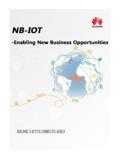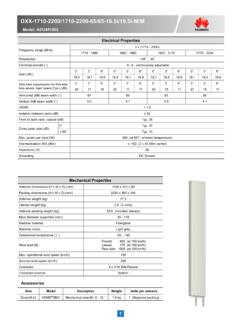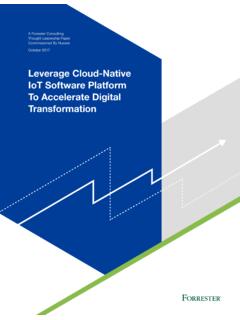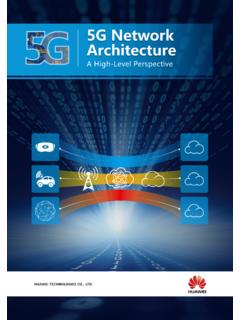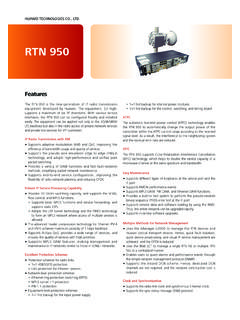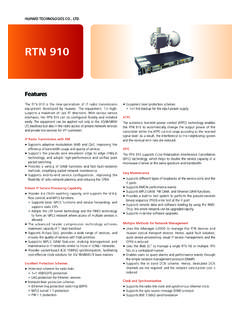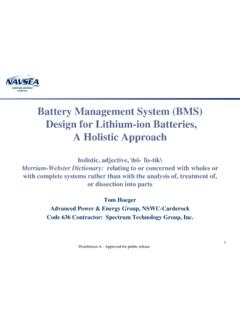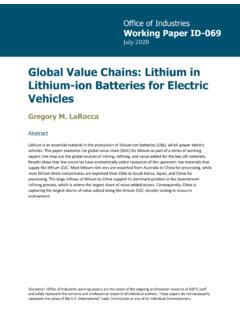Transcription of 5G Power Whitepaper - Huawei
1 5g power whitepaper Date 2019-02-27 Huawei TECHNOLOGIES CO., LTD. Contents Changes in the 5G Era .. 4 Network .. 4 Power Consumption .. 4 Energy Industry .. 5 Power Supply 6 Challenges Posed by the 5G Network Evolution .. 6 Challenges to Site Power Construction and Reconstruction .. 6 Mains Reconstruction Challenges .. 6 Power Distribution Challenges .. 7 Backup Power Challenges .. 7 Cooling Challenges .. 7 Equipment Room and Cabinet Space Challenges .. 7 O&M Challenges .. 7 Higher Electricity Fees .. 7 More complex Maintenance .. 7 Higher Lease 7 5G Power Requirements and Design Concepts .. 8 The General Requirements for 5G Power .. 8 Low Cost .. 8 Fast Construction .. 8 Less Energy .. 8 Smooth 8 Simple O&M .. 8 5G Power Concepts .. 8 Simple.
2 8 Intelligent .. 8 Efficient .. 9 5G Power Detailed Scenarios and Product Features .. 9 Reconstruction Scenario and Overlay Scenario .. 9 New Sites or Swapped Sites .. 11 Small Sites ..12 Intelligent Power ..12 Efficient Energy Saving ..15 Intelligent lithium Battery ..15 Smart O&M ..16 Figures Typical maximum Power consumption of a 5G site .. 4 Evolution of the frequency band proportion of a 5G site .. 5 Comparison between solar Power and thermal Power 5 Comparison between lithium battery and lead-acid battery 6 Rectifier efficiency evolution .. 6 5G indoor blade Power supply supporting simple deployment .. 9 High-density Power supplies, high-density lithium batteries, and high-density cooling devices simple reconstruction and overlay ..10 Full series of outdoor blade Power supplies supporting simple AAU installation.
3 11 5G intelligent Power of new outdoor sites supporting smooth 11 5G intelligent Power of new indoor sites supporting smooth evolution ..12 5G intelligent Power of new small sites supporting smooth evolution ..12 Cloud + AI-based 5G intelligent Four-layer intelligent collaboration achieving efficient E2E energy saving ..13 5G Power achieving intelligent cooling ..14 5G Power achieving peak clipping ..14 5G intelligent Power achieving efficient energy saving of Power supply-site-full link ..15 Changes in the 5G Era Network The 5G era is an all-mobile and all-connected intelligent era. In 2025, the number of global connections is estimated to exceed 100 billion. With that connection and communication between people and things are expected to become ever more common.
4 The service requirements of 5G network would become more diversified. There are three distinct 5G scenarios as defined by 3 GPP; enhanced mobile broadband (eMBB, 10 Gbit/s); Ultra reliable and low latency communications (uRRLC, 1ms); and massive machine type communications (mMTC, 1 million/km2). Power Consumption The Power consumption per unit of traffic (Watt/bit) is greatly decreased, but the Power consumption of 5G increases greatly compared to that of 4G. Noticeably, in the 5G era, the maximum Power consumption of a 64T64R AAU is 1000 1400 W, and that of a BBU is about 2000 W. Multiple bands in one site will be the typical configuration in the 5G era. The proportion of sites with more than five bands will increase from 3% in 2016 to 45% in 2023. As a result, the maximum Power consumption of a site will be higher than 10 kW, in a site where there is more than 10 bands, the Power consumption will exceed 20 kW.
5 In the multi-carrier sharing scenarios, this figure will be doubled. Typical maximum Power consumption of a 5G site 2G 3G Power consumption2G 4G Power consumption5G Power consumption Evolution of the frequency band proportion of a 5G site `A maximum of 5 bands are configured for a site in maximum of 7 bands can be configured for a site in maximum of 9 to 10 bands can be configured for a site in band 2 bands3 bands4 band5 bands1 2 bands3 4 bands6 7 bands1 2 bands3 4 bands5 bands6 7 bands8 10 bands5 bands In the 5G network, low-frequency and high-frequency bands will be deployed together. To meet the service requirements of increasing network capacity, a large number of end sites will be deployed. The number of network sites will increase greatly, and the Power consumption of the entire network will increase exponentially.
6 Energy Industry The Solar Photovoltaic (PV) Industry The global solar energy yield will increase from 391 GW in 2015 to 600 GW in 2020. In 2020, the global solar Power price will be the same as that of the thermal Power . The figure below shows the projected changes of cost in solar and thermal Power from 2015 to 2020. Comparison between solar Power and thermal Power costs Unit: USD/kWhPrice turning pointEstimated turning point time in different regionsIndia and AfricaLatin AmericaUnited StatesWestern ChinaAsia PacificEurope and JapanSolar Power costThermal Power cost lithium Battery Industry As the electric vehicle industry is growing vigorously around the world, it is estimated that the global lithium battery demand will reach 3000 GWh in 2030. Therefore, the cost of lithium battery will decrease rapidly.
7 The cost of lithium batteries and lead-acid batteries is expected to be the same in 2021 (see figure 1-4). Comparison between lithium battery and lead-acid battery costs The improved performance and expected cost reduction in the PV and lithium battery industries are bound to transform the telecom energy industry in making site Power more cost-efficient and environment-friendly. Power Supply Industry The conversion efficiency of rectifier in the telecom industry has reached 98%, and there is not much development space left. However, the efficiency of the entire site is still low. To achieve the lowest energy consumption of sites and the entire network in the 5G era, not only do we need to pay attention to the efficiency of individual components, but also the entire link and the whole site.
8 Rectifier efficiency evolution 5G era 2010 4G era 1990 20103G era 1980 19902G era 1980 EfficiencyEfficiency development space Challenges Posed by the 5G Network Evolution Challenges to Site Power Construction and Reconstruction Mains Reconstruction Challenges As the Power consumption of 5G sites increases, the mains capacity of existing sites may not meet the requirements of 5G deployment. Therefore, capacity expansion is required. The cost of mains capacity expansion is high, and the period of expansion is long, which greatly increases the duration and cost of 5G deployment. For example, over 30% of sites in China need mains modernization; the reconstruction period of the mains capacity expansion in South Africa is about 12 months, and that in Germany is about 10 months; the reconstruction cost in the Philippines is about 3000 USD per site.
9 Power Distribution Challenges The 5G single-band Power distribution requires at least two 100 A inputs (or four 32 A & three 63 A inputs). For example, over 75% DC circuit breakers of a carrier in China are 63 A or smaller. This does meet the operational requirements of 5G networks. In a high- Power remote AUU scenario, the voltage level drop in cables is too high, leading to large line loss. The input voltage of AAU is lower than the working voltage, as a result, the AAU cannot work. Backup Power Challenges As the Power consumption of 5G sites increases, the traditional backup Power strategies, systems and carriers will also need to be revamped. In addition, while the density of the traditional lead-acid battery is low, they are heavy and large in size. Some sites may have difficulty in accommodating the large weight and size of the lead-acid battery.
10 Cooling Challenges As the Power consumption of 5G sites expected to be doubled, the heat consumption of sites is also expected to go up in parallel. The heat dissipation capability of some sites cannot meet the requirements of 5G. The cost of modernizing a site cooling is high and the time required to complete the process is long, representing another barrier in accelerating the deployment of 5G. Equipment Room and Cabinet Space Challenges The remaining space in some existing cabinets is limited, which makes it difficult to accommodate 5G devices. Adding new cabinets needs more space. However, the space in some sites is limited. O&M Challenges Higher Electricity Fees The current electricity fee accounts for 1% 8% of the carrier's revenue. In the 5G era, with doubled Power consumption and the increasing electricity price, carriers are facing a higher electricity fee.
